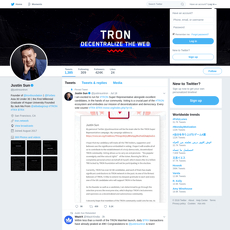John McAfee Review
John McAfee
twitter.com
John McAfee Twitter (@officialmcafee) Review Guide 2025: Everything You Need to Know + FAQ
Still trying to figure out what to make of @officialmcafee and what real lessons you can use today? I watched that feed shape narratives, swing sentiment, and spark more debates than most crypto influencers combined. If you’re tired of mixed opinions, wild claims, and recycled myths, this review is for you.
I’m going to cut the noise and give you a practical way to read that account—why it mattered, what to learn (and what to ignore), and how to protect yourself from lookalikes and hype. No hero worship, no hit pieces—just useful takeaways that still apply in 2025.
What’s confusing people right now
Let’s be honest—there’s a reason this account still gets so much attention years later. For many, it’s hard to tell what the point was—or what still matters now. Common questions I hear:
- Was it about privacy, politics, or pumping coins?
- Did the views help crypto or hurt it?
- Is the handle you see today legit—or an impersonator?
- Which parts of those old posts still matter if you’re trading or researching in 2025?
Those aren’t academic questions. In the 2017–2018 run, influencer posts often lined up with fast, short-lived moves in small-cap tokens. Media coverage documented “coin of the day”-style attention spikes and the hangover that followed when liquidity vanished. For context, see reports like Cointelegraph’s coverage of the end of those daily picks and the SEC concerns around promotions.
If you think that was just a bull-market quirk, there’s broader evidence backing the link between social chatter and crypto volatility. Multiple studies have found correlations between Twitter activity/sentiment and crypto returns and volume (examples: sentiment-driven dynamics, social signals and crypto prices). Translation: influencer content can be a genuine market risk factor—even if it isn’t a signal to trade.
Here’s what I’m going to do for you
I’ll keep this guide simple and practical. I’ll:
- Map the timeline so you can see how the account evolved
- Highlight the themes that actually influenced crypto conversations
- Explain the political stance in plain English so the privacy-first angle makes sense
- Show how to read old tweets without getting trapped by nostalgia or hype
- Give you a quick checklist to spot scams and impersonations
- Wrap with a short FAQ so you can get straight answers fast
Why this matters now
Influencers still move markets—maybe not like 2017, but enough to distort intraday sentiment and liquidity. Understanding one of the biggest personalities gives you an edge in spotting patterns, recognizing recycled narratives, and avoiding the same traps that caught people in past cycles.
Pro tip: Treat social buzz as a risk factor to manage, not a green light to trade. If attention spikes before liquidity, you’re the exit liquidity.
Who this is for
- Researchers who want clean context without chasing hearsay
- Traders who need a framework for evaluating influencer posts
- Privacy advocates curious how the politics tied into crypto principles
- Anyone tracking how old narratives still echo across crypto Twitter
Quick note on tone and accuracy
I’m not here to romanticize or smear. I’m here to make sense of an account that shaped a chunk of crypto history and still affects how people talk, trade, and secure their assets. When I point to market effects, I’ll reference public reporting or research. When I talk scams, I’ll give you a straightforward checklist you can use immediately. And when I mention @officialmcafee, I’ll also remind you how to verify the handle in a world filled with lookalikes.
Ready for the fast, balanced profile and why the Twitter presence mattered so much to crypto? In the next section, I’ll give you the quick bio timeline and the simple explanation of the political stance that powered the privacy-first message. Want the short version or the full story?
Who John McAfee was—and why his Twitter mattered to crypto
The quick bio timeline
John McAfee was the rare tech founder who became a cultural force. Here’s the fast context that explains why his Twitter account hit so hard in crypto.
- 1987–1994: Founded McAfee Associates and helped popularize consumer antivirus software. Left the company but kept the name recognition.
- 2000s–2012: Wandered, built new ventures, and lived loudly. His life became headline material, which later amplified his online voice.
- 2016: Ran for U.S. president (Libertarian Party). Twitter became his megaphone: pro-privacy, anti-surveillance, pro-civil liberties.
- 2017–2018: Crypto exploded. He embraced Bitcoin and the wider ecosystem, drew massive engagement, and turned his feed into a daily arena for hot takes and big claims.
- 2019–2020: Doubled down on privacy-first narratives, railed against taxes and surveillance, and clashed with regulators. Faced U.S. charges unrelated to his antivirus work.
- 2021: Died in Spain. His history—and his @officialmcafee feed—still echo in crypto debates today.
By the time crypto retail interest peaked in late 2017, his account had seven-figure reach. When he posted, people noticed—traders, journalists, regulators, and scammers. Influence like that doesn’t just “get likes.” It shapes narratives and, at times, behavior.
There’s data behind why that matters. Researchers have linked social media attention and sentiment to crypto volatility and short-term returns, showing that what high-profile accounts say can coincide with price and volume shifts. If you want hard evidence, take a look at peer-reviewed work on Twitter sentiment and Bitcoin returns (for example, Kraaijeveld & De Smedt, 2020). And the broader “influencer effect” on crypto prices is well-documented in studies of market-moving tweets (Ante, 2021).
His political stance, in plain English
He was libertarian to the core. That’s the key to understanding both his decisions and his Twitter.
- Personal freedom first: Decriminalize cannabis, end the war on drugs, and stop treating victimless behavior like a crime.
- Hands-off government: Non-interventionist foreign policy; skepticism toward surveillance, policing, and federal agencies (he even called for abolishing the TSA).
- Free markets without wealth redistribution: Let people keep what they earn; limit government’s reach into wallets and businesses.
- Free trade and open competition: Fewer barriers, more choice.
That worldview fed directly into his crypto beliefs: self-custody, privacy by default, tools that resist censorship, and a healthy distrust of centralized control. Whether you agreed with him or not, the through-line was consistent—and consistency builds a loyal audience.
How that stance showed up on Twitter
He didn’t tweet like a politician. He tweeted like a street-fighting founder with nothing to lose. It was raw, theatrical, sometimes reckless—and impossible to ignore.
- Privacy as a rally cry: He framed privacy as a basic human right and pushed people to use tools that protect it.
- Self-sovereignty every day: Hardware wallets, self-custody, and controlling your keys weren’t “tips”; they were the mission.
- Anti-surveillance, anti-censorship: He challenged regulators, called out overreach, and argued that software freedom beats bureaucratic control.
- Theatrics that drew headlines: He made outrageous, memorable statements that pulled mainstream media into crypto Twitter.
“If Bitcoin doesn’t reach $500,000 within three years, I will eat my d**k on national television.” — John McAfee, 2017
That one line captured why his account mattered, for better and worse: fearless, incendiary, and tuned to the attention economy. It wasn’t just talk—major outlets covered it, which sent even more eyeballs to crypto conversations (The Verge).
Here’s the emotional layer most people forget: in a world where banks felt untouchable and surveillance kept growing, his voice made people feel seen. He said the quiet part out loud—about taxes, about control, about freedom—and that gave early crypto adopters a banner to rally under. Whether you loved him or rolled your eyes at the stunts, you couldn’t scroll past without forming an opinion.
What drew people in
- Clear villains and heroes: He framed issues in simple terms—freedom vs. control, privacy vs. surveillance.
- Big, audacious claims: High-conviction predictions and public bets sparked instant debate.
- Direct, unfiltered language: No corporate polish, no talking points—just raw posts that felt human.
- Always-on engagement: He treated Twitter like a stage show, turning news cycles into ongoing storylines.
- Consistency of principles: You might argue with the tactics, but the privacy-first anchor didn’t move.
So what exactly did he tweet about most—and how do you separate the real signal from the spectacle when you scan that timeline today? Keep going; the patterns are clearer than you think.
Reviewing the @officialmcafee account content: themes, tone, and patterns
I spent years watching the @officialmcafee timeline become a lightning rod for crypto. It was raw, provocative, and often catalytic. If you strip out the theatrics and look closely, certain themes and patterns repeat—and those patterns still show up across crypto Twitter today.
Core themes you’ll notice
- Privacy as a non-negotiable right. He championed privacy coins, privacy tools, and the idea that surveillance harms everyone, not just “people with something to hide.”
- Self-sovereignty and self-custody. A consistent push to hold your own keys, avoid custodial traps, and reduce dependence on centralized gatekeepers.
- Anti-censorship, anti-control. Skepticism of governments, regulators, and large platforms—especially when they can freeze accounts, throttle speech, or pressure exchanges.
- Big, personality-driven declarations. Bold predictions, dramatic warnings, feuds, and stunts that guaranteed instant engagement.
- Security talk—part caution, part show. Practical notes about SIM-swaps and phishing sat alongside controversial product claims and public challenges.
“Privacy is a human right.”
Whether or not you agreed with every take, that line captures the backbone of the account—and why it resonated across a crypto crowd that values freedom and autonomy.
The signal vs. the noise
There was real signal in that feed—but it was mixed with serious noise. Sorting the two is how you avoid repeating 2017 mistakes.
- Signal you could actually use
- Self-custody reminders: Keep control of your keys. Don’t park serious funds on exchanges. Timeless advice that aged well.
- Security warnings: SIM-swap risk, phishing links in replies, fake giveaways, impostor accounts—common threats then and now.
- Privacy-first mindset: Even if you don’t use privacy coins, adopting a “least data exposed” posture helps you avoid future headaches.
- Noise that burned people
- “Coin of the day/week” hype: Short-lived pumps, brutal reversals. Classic attention storms that taught hard lessons.
- Extreme predictions: Entertainment value? High. Portfolio value? Often the opposite.
- Feuds and theatrics: Great for clicks, useless for research.
Independent research backs the caution. Multiple academic and industry studies tie social-media attention to short-term crypto volatility—spikes that can fade quickly. One widely cited NBER paper (Liu & Tsyvinski) shows attention proxies like Google Trends correlate with crypto returns in the short run, which aligns with what many traders saw play out during the 2017–2018 cycle. Translation: viral attention can move prices fast, but discipline and timing matter more than any one influencer’s hot take.
Notable campaigns and moments
- Privacy coin advocacy: Consistent praise for privacy tools and networks. These posts broadened awareness far beyond niche forums and pushed privacy into mainstream crypto debate.
- “Coin of the day/week” era (2017): Rapid-fire mentions that lifted thinly traded altcoins for hours or days—then gravity did its thing. If you traded that period, you remember the whiplash.
- Tax protest messaging: Tweets about refusing to file, challenging the system, and calling out overreach—reinforcing the account’s anti-authoritarian tone.
- Product showdowns (e.g., “unhackable” claims): Public challenges around security products triggered intense scrutiny from researchers and hackers. It drove engagement but also highlighted the gap between marketing and real security.
- High-visibility feuds: Sparring with regulators, critics, and other big accounts fueled the news cycle and kept the handle permanently trending in crypto circles.
Whether you were a fan or a skeptic, you couldn’t ignore it. The account functioned like a match dropped into a dry forest—sometimes lighting the way, sometimes starting wildfires.
Authenticity check
Given how often the name gets co-opted, never assume a screenshot or quote is real. Here’s how I verify before I share—or act:
- Confirm the handle and history: Check @officialmcafee, the account creation date, and old pinned posts to ensure continuity. Sudden tone shifts or missing years are a red flag.
- Open the original tweet: If someone shares a screenshot, use X/Twitter’s Advanced Search to find the post by keywords and date. If you can’t find the original, treat it as suspect.
- Cross-check with archives: Use the Wayback Machine or Archive.today to see earlier snapshots of the profile and posts.
- Beware fake “verified” signals: On modern platforms, a checkmark doesn’t guarantee authenticity. Look for long-term posting patterns, longstanding replies from known accounts, and consistent media in the feed.
- Scrutinize promotions: Undisclosed ads, “airdrop” links, or wallet-connect prompts in replies are common social-engineering traps. Never click connect from a tweet thread.
- Inspect screenshots: Misaligned fonts, inconsistent spacing, off-brand UI elements, or recycled media are tells. When in doubt, assume it’s fabricated.
I keep a simple rule: if a post pressures you to act fast, it’s almost certainly trying to benefit from your emotion, not your judgment.
Tone and posting patterns I noticed
- Direct, confrontational, and meme-ready: Short sentences, caps for emphasis, and lines designed to be quoted. Perfect for viral spread.
- Bursts over drip: Clusters of tweets around a single topic or campaign—often timed to grab the timeline and hold it.
- Identity-first framing: “Here’s what I believe” as the lead-in to product or coin talk—making every post feel like part of a larger philosophy.
- High variance in utility: A single day could contain a useful OPSEC reminder, a joke at a regulator’s expense, and a risky promotion. You had to filter in real time.
If that sounds familiar, it’s because much of crypto Twitter still runs on this blueprint: a powerful mix of belief, bravado, and speculation. The difference is whether you treat it as entertainment—or as a trading plan.
Here’s the question I always ask before I let a post influence me: is this principle-driven signal I can verify—or just a spark that could set my portfolio on fire? Keep that in mind as we look at what actually happened to markets when the account posted next...
Market impact: what changed when McAfee tweeted
I watched in real time how a single @officialmcafee post could yank attention toward a small-cap coin and send it vertical. That kind of attention shock didn’t just make charts lurch—it trained a generation of traders to chase candles and taught researchers how fast narratives can override fundamentals.
“In crypto, attention is a currency—and it devalues fast.”
When mentions moved markets
During the 2017–2018 window, mentions from that account often triggered violent, short-lived spikes in thinly traded altcoins. Classic examples people still bring up:
- Verge (XVG) — After being touted as a standout privacy play in late 2017, it saw a surge in price and search interest within hours. Volume spiked multiples above baseline, then much of the move unwound over the following sessions.
- ReddCoin (RDD) — A widely shared “coin of the day” mention was followed by a sharp rally and a rapid giveback, a pattern many small caps repeated: fast markup, illiquid exits, bagholders left behind.
- DigiByte (DGB) — Callouts correlated with outsized intraday volatility and liquidity gaps. The secondary effect—copycat mentions and spin-off hype—often outlasted the initial tweet.
Across dozens of these episodes, the playbook looked similar:
- Minutes 0–30: Attention floods in. Market orders rip through thin asks. Slippage explodes.
- Hours 1–12: Influencer amplification and quote-tweets keep the move alive. Late entrants get worse fills.
- 24–72 hours: Liquidity thins. Early buyers distribute into strength. Retracements take back a large chunk of gains.
- 1–2 weeks: Price gravitates toward pre-tweet trend unless fundamentals or broader market tailwinds step in.
What the data says: Social-media shocks move crypto, especially in small caps. That’s not anecdote—that’s consistent with peer-reviewed and working-paper evidence showing significant links between tweets, attention, and short-term returns/volatility in digital assets. A useful parallel is research on influencer effects like Musk’s activity and crypto prices (SSRN), and long-standing literature on social signals and market mood (Twitter mood and markets). The mechanism is simple: attention concentrates order flow in illiquid order books.
Trader takeaways I keep:
- Influencer-driven pumps tend to be short-lived and path-dependent. Early positioning and exit discipline matter more than conviction.
- Expect spread blowouts, failed breakouts, and heavy mean reversion. If you’re late, you’re exit liquidity.
- Watch volume/volatility first, not price. Attention fades faster than you think.
Privacy coins and decentralization
Beyond the fast pumps, one lasting effect of those posts was a clear lift in awareness for privacy-first tooling and self-sovereignty themes. Mentions of Monero (XMR), Zcash (ZEC), and Verge (XVG) helped push privacy into mainstream crypto chatter. You could see it in search interest spikes, exchange chatters, and new-user questions about wallets, mixers, and on-chain traceability.
The upside of that momentum:
- More people learned the basics of self-custody, address hygiene, and transaction privacy.
- Builders gained a larger audience for conversations around fungibility, censorship resistance, and threat models.
- It seeded later interest in DEXs, privacy-preserving wallets, and open-source security tools.
The downside:
- Hype bundled with privacy narratives made some newcomers conflate ideals with investment signals.
- Regulatory scrutiny intensified around privacy assets and centralized venues—remember the exchange delistings that rolled through 2019–2021 and beyond. The broader environment—not one account—drove those moves, but amplification didn’t help nuance.
- Some coins couldn’t back attention with sustained dev velocity, liquidity, or credible roadmaps, leading to boom-bust cycles.
Did that attention create lasting value? In a few cases, yes—projects with real engineering depth and community (think XMR’s ongoing development cadence) kept building through the noise. In others, attention outpaced fundamentals and the charts eventually told the truth.
The risk of relying on personalities
There’s a big difference between learning from high-signal voices and outsourcing your decisions. That difference shows up in the receipts. In October 2020, the U.S. SEC alleged that promotions tied to that account failed to disclose compensation for several ICOs (SEC Press Release, 2020-252). Regardless of how you feel about the case, the lesson is simple: undisclosed incentives can be lurking behind any post you see.
Use influencer content as a starting point, not a signal. I ask myself:
- Who benefits if this pumps today? Who benefits if it doesn’t?
- Is there enough liquidity depth to get in and out without getting shredded?
- What do on-chain metrics, repos, and funding look like? Is there shipping or just shouting?
- Are there upcoming token unlocks, exchange listings, or vest cliffs that change the calculus?
- Is this claim verifiable from primary sources, or is it a screenshot and a prayer?
How to trade around influencer moments (if you insist)
I’m not telling you to chase them. But if you refuse to sit out:
- Define exits before entries. Pre-set partials and a hard invalidation.
- Avoid market buys in illiquid books. Use limit and stop-limit orders.
- Size small. Treat it as a liquidity event, not a conviction swing.
- Track volume momentum and time-at-price. If participation fades, so does your edge.
- Verify the handle and timestamp. Impersonators and recycled screenshots are common during spikes.
Want a simple, no-nonsense workflow to turn old tweets into useful research without getting trapped by FOMO? In the next section, I’ll show you the exact checklist I use—so you can turn noise into signal and keep your risk tight. Ready to see how I do it in 4 steps?
How to use the John McAfee Twitter archive today (without getting trapped by hype)
“When you can’t tell whether a tweet is alpha or bait, treat it as bait until the data proves otherwise.”
I still pull up the @officialmcafee timeline when I’m researching historical narratives and market reactions. But I don’t romanticize it. I use it like a lab notebook: what was said, what happened next, and what patterns still repeat across crypto Twitter today.
Research workflow I recommend
Think “claims to checks.” If a bold statement pops up in the archive, I do this:
- Start with context: Use X’s Advanced Search by date, and mirror it on Wayback Machine or Nitter. Look at the replies and quote-tweets around the same day. Was it part of a broader news cycle or a one-off hype burst?
- Verify the source: Check the handle, past usernames, and profile history. Screenshots float around with altered timestamps—don’t trust them without a link you can click.
- Triangulate with data: Did price, volume, or social mentions actually move within 24–72 hours? Tools like CoinGecko, recent listings, and social analytics (e.g., Santiment) help you map reaction vs. noise.
- On-chain checks: If a tweet praised a token, I look at Etherscan, Solscan, or the relevant explorer:
- Holder concentration (are a few wallets in control?).
- Recent large transfers around the tweet date (possible orchestrated moves).
- Contract age, audits, and upgradeability proxies.
- Liquidity and structure: Thin order books amplify influencer shockwaves. Check exchange depth and market maker presence on Cryptowatch or Kaiko (if you have access). A tweet can move microcaps hard—then give it all back.
- Tech reality check: Cross-reference GitHub commits, roadmap delivery, and active maintainers. Privacy coins with steady core repos (e.g., Monero’s long-running activity) behaved differently from 2017 ICOs that went quiet. If the code has been dead for years, the “narrative” is a museum piece.
- Narrative risk: Was the post promising a partnership, a listing, or “adoption next week”? I log the claim, then look for announcements in the following 30 days. If nothing landed back then, treat the same pattern as a red flag now.
- Thesis vs. outcome log: Keep a simple doc:
- Claim
- Evidence for/against (data and links)
- Outcome after 7/30/90 days
- What I’d do differently next time
Why this style works: multiple studies have shown social media can shift short-term crypto prices. Research on pump-and-dump coordination (Hamrick et al., 2019) and social-sentiment effects (Mai et al., 2018) both point to the same takeaway: tweets can nudge markets, but persistence depends on fundamentals and liquidity.
Real example workflow: You find a 2017 tweet hyping a small-cap privacy coin.
- Check if the token still trades and where (many migrated or died).
- Look at holder distribution on-chain. If top 10 wallets still hold 70%+, that’s structural risk.
- Scan commit history. Yearly commits dropping to near-zero by 2019? That explains why any spike didn’t last.
- Compare daily volume pre- and post-tweet window. If the spike was all exchange wash or short-lived, you’ve learned a durable lesson about influencer-driven whipsaws.
Red flags checklist for social posts
Different year, same playbook. If you see any of these in an old tweet—or in something similar today—slow down:
- Undisclosed promotions: No #ad or clear disclosure, yet heavy shilling. Regulators have called this out repeatedly (see the SEC’s 2020 release on undisclosed ICO promotions: sec.gov/news/press-release/2020-247).
- Guaranteed returns or “can’t lose” language.
- Vague partnerships: “Top bank deal soon,” with no verifiable PR from the counterparty.
- Time pressure: “First 100 wallets,” “ends in 30 minutes,” or countdowns designed to bypass thinking.
- Unverifiable screenshots: Especially exchange emails, listing approvals, or fake celebrity DMs.
- Bot amplification: New accounts, near-identical replies, sudden follower surges. Engagement should look organic—if it doesn’t, assume coordination.
- Off-platform payments: “Send crypto to join a private group” or “gas refund” gimmicks.
- DMs from lookalike handles: Variations like @0fficialmcafee or swapped characters.
If you need a sanity check, the FTC’s endorsement rules are a quick read and apply to crypto promos too: Endorsements & Influencers.
Newcomers vs. veterans
If you’re newer to crypto:
- Use the archive to learn the “2017 formula”: tiny cap + thin liquidity + bold promise + rush = short, violent pumps that trend back to baseline.
- Practice “thread autopsies.” Pick one viral thread, list the claims, and try to verify each. You’ll get fast at spotting weak narratives.
- Bookmark official sources for any project mentioned, and learn to compare whitepaper claims to code and shipped features.
If you’ve been around a while:
- Profile the influencer mechanics: cadence, language, timing (weekends, low-liquidity hours), and cross-promo networks.
- Build a “repeat patterns” notebook: recycled hype lines, recycled charts, recycled fake partnerships.
- Quant your guardrails: no-trade rule within X minutes of a viral post; only act after liquidity and depth criteria are met; require two independent confirmations for any “news.”
Security basics
Hype feeds exploits. These guardrails save accounts, not just money:
- Never connect your wallet from links in replies or quote-tweets. Type the domain manually or use a bookmark you created.
- Use a hardware wallet for anything you plan to keep. Hot wallets are for spending, not saving.
- Prefer passkeys or app-based 2FA over SMS. SIM swaps still ruin weeks.
- Scrutinize EIP-712 messages. If you don’t understand what you’re signing, cancel. Watch for unlimited approvals; regularly audit with revoke.cash.
- Adopt burner wallets for testing new dapps. Assume at least one experiment will go wrong this year.
- Check domains for small typos and certificate mismatches. If a “support” link appears under a high-engagement tweet, treat it as malicious until proven otherwise.
- Don’t scan random QR codes from screenshots. Phishers love urgency + mobile users.
History is a teacher, not an entry signal. The archive is valuable when it helps you separate timeless principles (privacy, self-custody, skepticism) from tactics that age poorly (undisclosed promos, guaranteed gains). Want fast answers to the questions everyone asks—like whether those tweets really moved prices and how to verify if @officialmcafee is legit today—or which promotions were disclosed and which weren’t?
FAQ: straight answers people keep asking
What was John McAfee’s political stance?
Short version: a hard libertarian streak that prioritized individual freedom. He backed decriminalizing cannabis, ending the war on drugs, non‑intervention abroad, free trade, and a free‑market economy without wealth redistribution—he even argued for abolishing the TSA. That worldview aligned with the “privacy-first, self-custody, minimize gatekeepers” message that resonated with crypto natives.
Why it mattered on Twitter: the politics framed the crypto takes. When he pushed privacy coins or slammed surveillance, it wasn’t random—it was consistent with his broader worldview.
Did his tweets really move prices?
At times, yes—especially in the 2017–2018 cycle when the retail crowd treated influencer timelines like a Bloomberg terminal for microcaps. Two examples from that era that I watched closely:
- “Coin of the day” bursts: Small-cap coins named in real time often spiked within hours—sometimes triple digits—then retraced hard within days. It was classic attention liquidity: thin books + viral mentions = whipsaw candles.
- Privacy coin spotlights: Mentions of Monero, Zcash, and Dash regularly juiced social volume and short-lived price momentum, even when fundamentals didn’t change.
This isn’t unique to one account. Academic work keeps finding links between social buzz and crypto volatility/volume. See, for instance, Hamrick et al. on coordinated pumps (Anatomy of a Cryptocurrency Pump-and-Dump Scheme) and Mai et al. on social media effects (Social Media, News and Bitcoin).
Takeaway: treat social buzz as a risk factor, not an entry signal. If you trade it, know you’re playing musical chairs.
Is @officialmcafee still active and legit?
Impersonation never went out of style. If you’re looking at an account claiming to be him or “his team,” run this quick check:
- Handle and history: Confirm the exact handle, scroll the timeline years back. Sudden creation or gaps are red flags.
- Cross‑verification: Look for mentions from established journalists, archives, or original media appearances tying back to that handle.
- Behaviors: Any DMs, giveaways, wallet connects, or “send 1 ETH get 2 back” nonsense = automatic block/report.
- Platform signals: Verification isn’t absolute proof, but an unverified, brand‑new account using his name is a non‑starter.
I’ve seen sophisticated fakes with old screenshots and AI-edited clips. Always source the original tweet link before sharing or acting.
Did he have a coin or endorse projects?
He promoted multiple projects, especially in the 2017–2018 ICO wave and beyond. Regulators later alleged that some promotions were undisclosed paid endorsements. The SEC’s 2020 complaint is the canonical reference here: SEC Charges John McAfee for Touting ICOs.
What to learn from that era:
- Disclosure matters: Assume compensation unless proven otherwise.
- Promotions ≠ validation: Influencers market narratives; they don’t guarantee delivery.
- Paper trails help: Use on‑chain data, GitHub activity, and independent audits—not tweets—to validate claims.
What’s the biggest takeaway for crypto users today?
Keep the principles, not the playbook. Privacy, self‑custody, and questioning centralized gatekeepers age well. FOMO entries on viral posts do not. Build a workflow that outlives any single influencer.
- Principles: Own your keys, audit your sources, protect your metadata.
- Process: Treat big claims as research prompts, not conclusions. Timebox your due diligence and write down the thesis before entering anything.
How do I verify a screenshot or quote that’s flying around?
Simple, fast method I use:
- Search the exact text in quotes on X/Twitter and Google; if it’s real, someone will link the original.
- Use the Internet Archive or Nitter mirrors to confirm timestamps.
- Check font/spacing inconsistencies—many fakes miss these small details.
Any data-backed tips for trading around influencer posts?
If you must trade it, consider these patterns supported by research on social-driven pumps and attention shocks:
- Fade the first pop: Spikes on thin liquidity often mean mean-reversion within 24–72 hours.
- Watch liquidity, not likes: Order book depth and spreads tell you more than engagement counts.
- Volatility tax is real: Higher slippage and fees can erase any “edge” from chasing social momentum.
Sources worth scanning: Hamrick et al. on pump dynamics (arXiv), and broader social‑media/crypto links from peer‑reviewed and SSRN studies (SSRN).
Want my bottom line and the exact action steps I use when crypto Twitter turns chaotic? That’s next—ready for a no‑BS checklist you can actually run this week?
My bottom line
That account was a catalyst—equal parts sharp signal and loud noise. The lasting win is simple: keep the principles (privacy, self-custody, skepticism of authority) and ditch the reflex to trade on celebrity heat. Markets still react to loud voices, but the edge belongs to the person who can separate attention from value and hype from truth.
Rule I keep: principles scale, hype fades.
If you want a quick gut-check on why this matters, research keeps showing that attention shocks move prices fast and then often mean-revert. Example: documented pump-and-dump runs coordinated on social channels produced sharp, short-lived jumps followed by underperformance SSRN: Hamrick et al., 2019. Broader attention proxies (Google Trends, Wikipedia views) correlate with crypto price swings and volatility, especially during speculative phases Kristoufek, 2013. Pair that with the steady stream of wallet-drainer thefts baited through social posts—hundreds of millions lost in 2023 alone, per ScamSniffer and multiple industry forensics reports—and you’ve got your playbook: respect the megaphone, distrust the impulse.
Action steps you can take today
- Verify any @officialmcafee content before you share or act on it.
- Check the handle, creation date, and post history. A blue check is meaningless post-2023.
- Cross-check claims via an external source (official site, press release, or an archive snapshot).
- Assume any “giveaway,” airdrop link, or surprise mint in replies is a drain. If you’re curious, paste the domain into a scam database first (e.g., ScamSniffer).
- Use a research checklist for every hot take on crypto Twitter.
- Context: Is this tied to an upcoming unlock, listing, or governance vote? Check calendars like CoinMarketCal.
- Data: Look at volume, liquidity, and top holder concentration. Free tools like Etherscan and community Dune dashboards help.
- Attribution: Is there a disclosed relationship? Regulators have charged undisclosed promos before—treat non-transparent shilling as a red flag.
- Timing: Attention spikes often reverse in 24–72 hours (classic attention shock pattern backed by research). Plan risk, not FOMO.
- Write it down: Keep a simple log: “thesis → entry → exit → outcome.” Your future self will thank you.
- Prioritize self-custody and security basics.
- Use a hardware wallet for anything you care about. Split funds across hot/cold wallets.
- Never sign from links in replies. Navigate to official domains manually.
- Set spending limits and revoke risky allowances regularly via revoke.cash.
- Add a passphrase and unique email per exchange or wallet app. Turn on phishing-resistant 2FA (FIDO2/U2F keys).
- Treat influencers as inputs, not signals.
- Use posts as a starting point to research themes—privacy, self-sovereignty, security—rather than a reason to buy or sell.
- If you can’t explain your edge in two sentences without naming a person, you don’t have one yet.
Editorial note
On Cryptolinks, I aim for clear, useful reviews that help you make better decisions, not louder ones. If there’s a legacy crypto account or archive you want covered next, drop a comment or ping me with a link. I’ll add it to the queue and keep it real.
Conclusion
This account helped shape a whole era of crypto Twitter—some of it productive, plenty of it chaotic. Take the durable lessons forward: guard your privacy, keep your keys safe, and challenge big claims—even when they fit your worldview. The market rewards independent thinking and good process. The rest is just noise.
Quick recap worth saving: verify the source, measure the attention shock, check the data, protect your wallet, and make your own call. That’s how you stay safe, informed, and a step ahead.
CryptoLinks.com does not endorse, promote, or associate with Twitter accounts that offer or imply unrealistic returns through potentially unethical practices. Our mission remains to guide the community toward safe, informed, and ethical participation in the cryptocurrency space. We urge our readers and the wider crypto community to remain vigilant, to conduct thorough research, and to always consider the broader implications of their investment choices.













